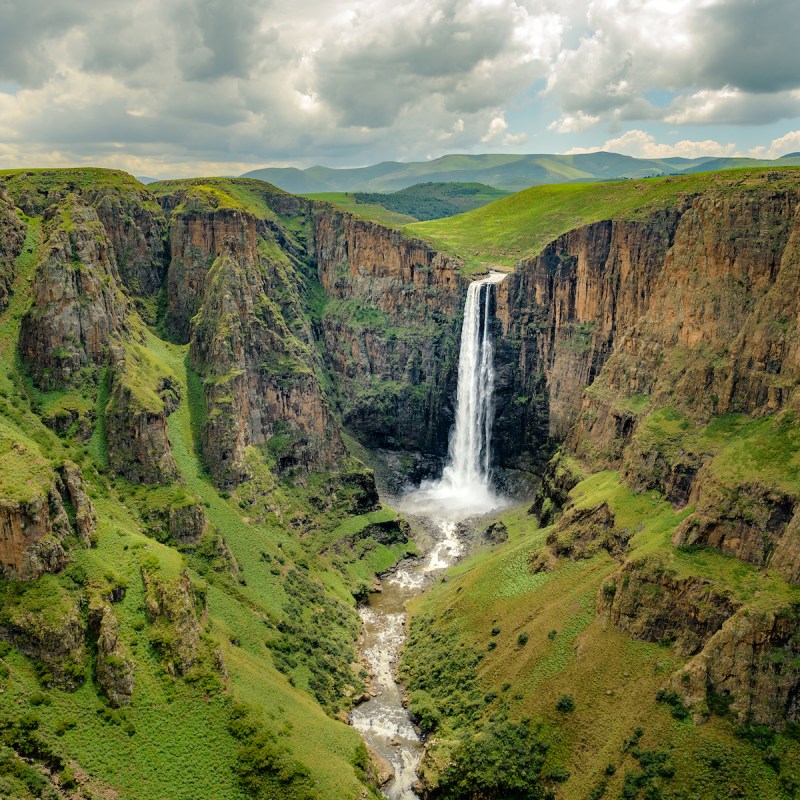
I’m not suggesting that you should write off going on safari to South Africa, Kenya, or Tanzania, nor that you should erase the Egyptian pyramids or the Moroccan medinas from your bucket list. But there are many great countries on the African continent that don’t get the attention they deserve, and it is these unique gems that deserve a place on your bucket list.
Videos by TravelAwaits
Here are my suggestions for five unique African countries that should be on your radar.

1. Zambia
This magnificent African country sitting right in the heart of the African continent has been my adopted home for the last 30 years. Zambia is well off the beaten path when it comes to safaris and tourism. There are many people out there — members of my extended family included — who have no idea exactly where it is and would struggle to point Zambia out on a map. Indeed, somewhere around 50 percent of the visitors who set foot in the country, only come to visit the famous Victoria Falls — but there is so much more to discover here.
National Parks And Protected Game Reserves
Around 30 percent of Zambia is part of a national park or protected game reserve, and there’s an abundance of wildlife here. You definitely don’t have to worry about it being crowded — unlike elsewhere on the continent. Plan a sensational safari in South Luangwa or Kafue National Parks to see herds of elephants, packs of wild dogs, prides of lions, and much more. Go down the Zambezi River in a canoe in the Lower Zambezi National Park. Visit Victoria Falls, known locally as Mosi-oa-Tunya (The Smoke That Thunders) plunging a misty 590 feet into the narrow Batoka Gorge below.
See The Big Five And Victoria Falls
Zambia is named after the Zambezi River, the fourth biggest in Africa, and is a completely landlocked nation. The country is renowned for its copper and emeralds, as well as the famous Victoria Falls, which at 5,600 feet wide is double the height of Niagara Falls, and the largest curtain of falling water in the world. All of Africa’s Big Five (lion, leopard, elephant, rhino, and buffalo) can be found here, as well as an array of adventure activities, including white water rafting, canoeing, helicopter flights, and bungee jumping, just to name a few.
Zambia is also home to a couple of really special “orphanages.” Chimfunshi Wildlife Orphanage is a chimpanzee sanctuary home to around 130 adult and young chimps, and the Game Rangers International Elephant Orphanage rescues, rehabilitates, and releases orphaned elephant calves. Both are worth a visit if you have the opportunity.

2. Malawi
Malawi is often referred to as “The Warm Heart of Africa” because of the friendliness of its people. This sub-Saharan landlocked country is nestled between Zambia, Tanzania, and Mozambique.
Lake Malawi, a UNESCO World Heritage Site, is the second largest lake in Africa (the largest is Lake Tanganyika in neighboring Zambia). The lake is surrounded by sandy tropical beaches and boasts countless bays and islands. Its crystal clear waters are home to over 600 rare species of fish — making it perfect for snorkeling, boating, and scuba diving. But Malawi is more than its diverse natural landscapes. Travelers could spend weeks here exploring.
Here are some of the top places to visit in Malawi.
Lilongwe
Travelers often skip African cities for the wilderness, but Malawi’s capital has a number of activities and attractions to keep you occupied. Shoppers will love the many local markets. Alternatively, a hike up Nkhoma Mountain will earn you panoramic views over the city. A visit to the Lilongwe Wildlife Centre, the country’s only animal sanctuary, is a must.
Lake Malawi National Park
The tropical waters of Lake Malawi are teeming with colorful fish, sandy beaches, and rocky islands.

Majete Wildlife Reserve
This is a great place to spot the Big Five and at the same time support a conservation success story. Poachers and human encroachment had destroyed the wildlife in the park, but in 2003, the non-profit conservation group African Parks partnered with the Malawi Department of National Parks and Wildlife and reintroduced black rhinos, lions, giraffes, and more. Almost two decades later, flourishing wildlife brings visitors to the park.
The Shire Highlands
Visit southern Malawi where farmers grow tea and coffee. First cultivated here by the British in the 1900s, tea plants thrive in the elevation of the Shire Highlands thanks to its cooler climate. Tour Satemwa Tea and Coffee Estate and relax with a cup of earthy oolong or natural-processed arabica.
Mt. Mulanje
Fit and adventurous travelers can organize 4-day treks 9,824 feet up the slopes of Mt. Mulanje with local guides.
Liwonde National Park
Here you’ll find hippos and crocodiles in the Shire River, and elephants, zebras, kudus, leopards, and lions on the nearby plains.

3. Cape Verde
A stunning volcanic island chain, Cape Verde (also called Cabo Verde) comprises 10 islands and 5 islets 310 miles off the coast of West Africa, of which Sal and Boa Vista are the most known to tourists — predominantly for their beaches. Besides Sal and Boa Vista, there are eight other islands: Santiago, Fogo, São Vicente, Santo Antão, Maio, Brava, Luzia, and São Nicolau. Cape Verde is famous for its warm tropical climate, volcanic islands, wonderful musicians, and delicious cuisine. Americans may not have heard much about Cape Verde, but for many Europeans, the islands are a popular winter escape that’s relatively close to home.
The Cape Verde islands have no shortage of activities: driving tours of the sand dunes, hiking, water sports that include kite surfing and diving, and of course, lovely secluded white sand and black sand beaches. The Cape Verde islands are also rich in culture and festivals.
What Each Island Offers
Each of the islands has its own charm. Santo Antão is home to stunning nature, mountains, and lush vegetation, Fogo is known for its volcano, and São Vicente is the cultural heart of the archipelago. Maio, Brava, and São Nicolau are hardly visited and are great places to discover authentic Cape Verdean culture. Santa Luzia is uninhabited, and Santiago, the main island, has a bit of everything. Island hopping is a great way to experience the Republic of Cabo Verde.
Pro Tip: The islands are home to the third-largest population of nesting loggerhead turtles. Sal is one of the three islands where most of the turtles nest. From July to October, you can spot these creatures as they come on land to nest.

4. Senegal
The West African nation of Senegal, officially the Republic of Senegal, offers a unique blend of bustling urban markets, beautiful beaches, and wonderful nature reserves. This former French colony has several major cities, including the capital Dakar and the historic Saint-Louis, as well as over 300 miles of coastline on the Atlantic Ocean. Northern Senegal is famous for its birdlife with many sanctuaries and reserves, including the Djoudj National Bird Sanctuary, which attracts birdwatchers from all over the world.
Dakar
The capital of Senegal is home to numerous African art museums and monuments to enjoy — be sure to pass by the curious Soviet-style African Renaissance Monument and the acclaimed Museum of African Arts. Be sure to also visit Plage de Virage, a popular spot with local surfers.
Gorée Island
Just off the coast of Dakar is Gorée Island, home to Maison des Esclaves and its Door of No Return, a museum and memorial to the victims of the Atlantic slave trade. Many African Americans like to visit the place for the history it holds.

Saint-Louis
In 1659, French traders established Saint-Louis on the island of Ndar. The town was the former colonial capital of Senegal and is steeped in history. In 2000, the old town was recognized as a UNESCO World Heritage Site. As you cross the Faidherbe Bridge from the mainland, it’s like stepping back in time, as you find yourself surrounded by Saint-Louis’ colorful crumbling colonial buildings and sandy streets.
Pro Tip: The Saint-Louis Jazz Festival attracts musicians from all over the world. Founded in 1993, this is one of the largest jazz festivals in Africa and takes place each year in April and May.
Touba
The attractions at Touba are somewhat different from elsewhere in the rest of the country. The town is home to the colossal Great Mosque, looming minarets, and countless other pilgrimage shrines and attractions.

5. Lesotho
The amazing, high-altitude, landlocked mountain kingdom of Lesotho, is completely encircled by South Africa and crisscrossed by a network of rivers and mountain ranges. This unique African country is known for its breathtaking scenery, which includes snow-capped mountain ranges during the winter.
Visiting Lesotho, the sky seems to stretch away forever, with beautiful, dramatic clouds that seem to stretch up to incredible heights before releasing showers of rain in the distance. Streams cascade down mountainsides, and rivers wind around foothills and mountains before forming fantastic gorges. Spectacular sunsets are the order of the day, especially as you often find yourself looking down on the clouds.
Perfect For Nature Lovers
This mystical country has many attractions for nature lovers. Visit the Maletsunyane Falls, hike to Lesotho’s highest point, Thabana Ntlengana, experience the Mohale Dam, and journey to the Kome caves that hold thousands of years of history. The Sehlabathebe National Park in the Maloti Mountains boasts rich plant, animal, and bird life, and if you’re lucky, you’ll spot the rare bearded vulture here. Lesotho also hosts the Roof of Africa motorcycle rally annually and is home to the world’s longest commercial single-drop abseil, the world’s highest pub, the Sani Top Chalet (9,430 feet above sea level), and Afriski, Sub-Saharan Africa’s only ski resort.

Lesotho is one of Africa’s most intriguing and rewarding off-the-beaten-track gems. With its lowest point at 4,593 feet, the country differs from most of its African counterparts, with a cooler climate, snowy winters, and dramatic summer storms. Lesotho remains a country largely untouched by development and tourism, and one of the most unique and exotic places to visit on the continent.
Whether it’s unexpected beach breaks, once-in-a-lifetime experiences in the Saharan drylands, or city-hopping across different nations, there is surely no shortage of landmarks to be visited in Africa.

